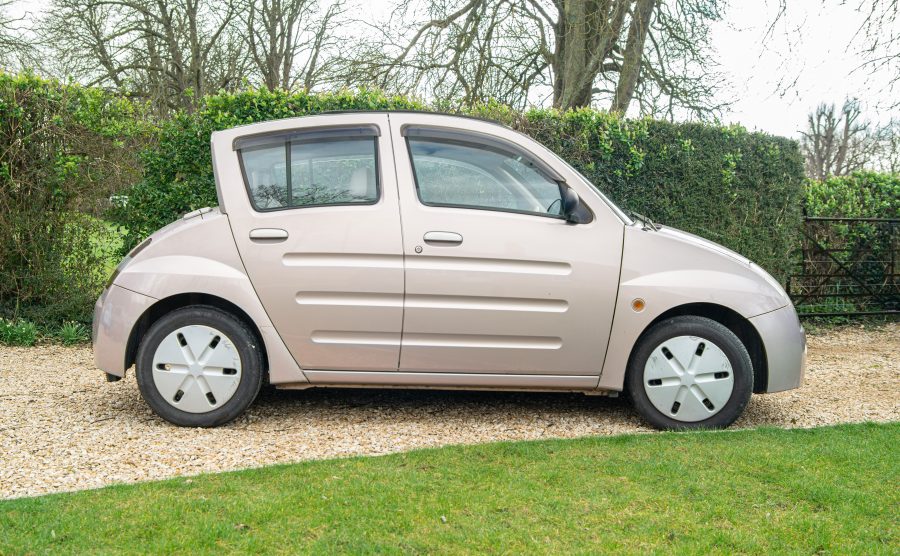We would not be surprised if you have never heard of the Toyota WiLL Vi. Though distinctively styled, this four-door saloon was produced for only two years on a low-volume schedule. It was also only available in Japan. And as if to try and guarantee its international invisibility, you cannot find a Toyota logo anywhere on the exterior or interior.

It arrived in January 2000 as the result of a joint marketing project between a handful of leading Japanese companies, Toyota being the only vehicle manufacturer among them. The aim of this diverse group was to create a wide range of WiLL-branded products that appealed to the individuality and preferences of millennials as the new generation of consumers.
The WiLL Vi (pronounced ‘vee-eye’) was Toyota’s opening contribution to this collection and it communicated the WiLL brand’s hallmark qualities of fun and authenticity by combining fashionable, neo-retro styling with up-to-the-minute driving performance.

Its symmetrical design was full of converging planes and expressive angles, with distinctive corrugations along the sides and a reverse-angle rear window that created a silhouette officially described as ‘reminiscent of the horse-drawn carriages of yesteryear.’ The front and rear were almost identical in appearance and shaped to form a friendly face, while the blistered arches and 15-inch wheels gave the design a strong feeling of stability.

The Toyota WiLL Vi delivered on that promise, too, with responsive performance underpinned by a platform and powertrain taken directly from the first-generation Toyota Vitz (Yaris), which had just scooped the honour of Japanese Car of the Year. It adopted the supermini’s more powerful 88PS 2NZ-FE 1.3-litre 16v engine, paired with a four-speed automatic gearbox – a combination that achieved class-leading fuel economy at the time.
In that regard, the model’s environmental qualities were particularly highlighted to its target demographic. Highly recyclable Toyota Super Olefin Polymer was adopted for the bumpers and interior plastics, and the sound deadening was made using shredded materials from end-of-life vehicles. All use of lead was also deleted from the production of the radiator, heater core and wiring loom.

Moving inside, the quirky WiLL Vi was presented with a range of rounded shapes, rich textures and autumnal tones. It created a relaxing atmosphere that was supposed to feel more like being at home than in an automobile. In that regard, bench seats were fitted front and rear to generate the sense of sitting on a living room sofa, which necessitated the use of a column-mounted gear shift. Storage opportunities were liberally dotted around the cabin to convey a user-friendly feel. Similarly, the main control panel was a simple, intuitive design and the instruments were centralised to minimise visual refocusing.

Production of the Toyota WiLL Vi concluded in December 2001 after some 16,000 units had been sold. However, during the same two-year period, Toyota produced more than 697,000 examples of the regular Vitz in Japan. So the WiLL Vi was a rarity even when new, and 20 years down the line has become something of a unicorn, especially in the UK where just 21 imported examples are currently registered with the DVLA.

The lavender example pictured here is one of those UK-registered cars and it is being offered for sale by auction through Car & Classic. Offered with no reserve price, this could be your opportunity to get hold of one of the most distinctive – yet mechanically conventional – Toyota models of recent history.





Hi, they also did a Will VS and I believe I have the only one on the road in the UK! I always get stopped in the garage and asked what kind of car it is because it only has WILL badges!
Saw 2 yesterday in Harvester carpark in Eastleigh
Richard Doyle
Hi I am glad you liked my toyota will you purchased which I had for 6 years she never let us down and that your wife enjoys driving it.
We have a blue one now with a music centre in the boot which sounds just like the a sixties juke box, people always stops to talk to use and listen to the music whilst we are out shopping.
The car has been filmed for a television program Bangers and Cash at our local stately home Lytham Hall and in the town it self but I don’t know when it will be.
Dorothy
Please amend my name on my on my previous email has my name is Dorothy Whitehorn for my reply to Richard Doyle.
Thank you
Hi Dorothy,
We have just amended your name to the correct spelling.
If you require any further changes, please let us know.
Thanks.
Hi Dorothy,
I have just watched bangers and cash, and seen your Toyota will, car. It looks lovely and quirky. If ever you think of selling it, would you please keep me in mind, I would like to buy it for my wife. Thank you.
Michael White
We have just visited Tesco in Ilfracombe and we saw willvi on the car park the only one we have ever sean
Hi, have just seen a WILL VI In the Aldi car park in Broughton Astley in Leicestershire…. So unusual, reminds me a bit of a French Renault 2CV . Chatted to the lady driving it, said it was 25/26 years old. great condition, I thought it was a new quirky designed car..🤪 we need more unusual cars
Loved it . Made me smile 😊
Just spotted one in Narborough Leicestershire… first one I’ve ever seen… had to look it up 😊